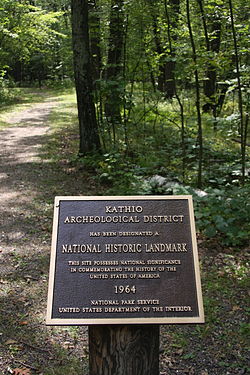Mille Lacs Kathio State Park
|
Kathio Site
|
|

Kathio Archeological District
|
|
| Location | Mille Lacs County, Minnesota |
|---|---|
| Nearest city | Vineland, Minnesota |
| NRHP Reference # | 66000403 |
| Significant dates | |
| Added to NRHP | October 15, 1966 |
| Designated NHLD | July 19, 1964 |
Coordinates: 46°07′44″N 93°44′26″W / 46.128849°N 93.740527°W Mille Lacs Kathio State Park, also known as Kathio Site, is a Minnesota state park on Mille Lacs Lake. The park preserves habitation sites and mound groups, believed to date between 3000 BC and 1750 AD, that document Sioux Indian culture and Ojibwe-Sioux relationships. The park contains 19 identified archaeological sites, making it one of the most significant archaeological collections in Minnesota. The earliest site dates to the Archaic period and shows evidence of copper tool manufacture. The Sioux lived in this area roughly until the 18th century, when many bands of Sioux were moving southward into the prairies and river areas of southern Minnesota. At the same time, Ojibwe (Anishinaabe) were moving in from the east. Ojibwe oral tradition, published by William Whipple Warren, suggests that there was a battle in which they successfully took control of the area from the Sioux; as of 2012 no archaeological evidence has as yet been found to corroborate this battle narrative.
Around the time of contact in the 1850s, loggers came to the area. The next 50 years resulted in a large quantity of trees being felled and floated down the Rum River or across Mille Lacs Lake to sawmills.
The name "Kathio" is actually a corruption of "Izatys", a name the Mdewakanton Sioux people gave themselves. Explorer Daniel Greysolon, Sieur du Lhut visited the area in 1679. He named the area "Izatys", but his poor handwriting led people to mistake the "Iz" as a "K". Further errors led to the name being transliterated to "Kathio".
...
Wikipedia


